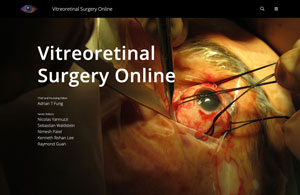13 Clinical Trials Summary
13.0 Introduction
13.1 Cornea
13.2 Cataract
13.3 Medical Retina – Age-Related Macular Degeneration (AMD)
13.4 Medical Retina - Diabetes
13.5 Medical Retina – Retinal Vein Occlusion (RVO)
13.6 Vitreoretinal Surgery
13.7 Glaucoma
13.8 Oculoplastics
13.9 Paediatrics
13.10 Neuro-Ophthalmology
13.11 Ocular Oncology
13.9 Paediatrics
ICROP [lxxxv]
A Consensus Statement
A CLASSIFICATION SYSTEM for the clinical features of ROP:
Defines Zone, Stage, Plus disease, Pre-plus disease and AP-ROP features
Prematurity*, C.o.R.o. 2005. The International Classification of Retinopathy of Prematurity Revisited. Archives of Ophthalmology 123(7) 991-999.
CRYO-ROP [lxxxvi]
Defined threshold disease
Cryotherapy for threshold ROP in BW ≤ 1250g, halves risk of poor structural outcome and reduces poor VA outcome by 1/3, at 1 - 15 years
Threshold = 5 continuous, or total 8 clock hrs, of stage 3 disease in Zone 1, or 2 with plus
Palmer, E.A. 1990. Results of U.S. randomized clinical trial of cryotherapy for ROP (CRYO-ROP). Doc Ophthalmol 74(3) 245-251.
ET-ROP [lxxxvii]
Defined pre-threshold disease Treat high risk (type 1) pre-threshold ROP with laser:
- Zone 1 any stage with plus
- Zone 1, Stage 3 without plus
- Zone 2, Stage 2 - 3 with plus
Observe low risk (type 2) pre-threshold ROP:
- Zone 1 Stage 1 - 2 without plus
- Zone 2 Stage 3 without plus
Palmer, E.A. 1990. Results of U.S. randomized clinical trial of cryotherapy for ROP (CRYO-ROP). Doc Ophthalmol 74(3) 245-251.
STOP-ROP [lxxxviii]
Supplemental O2 doesn’t affect progression from pre-threshold to threshold
LIGHT-ROP [lxxxix]
Light exposure doesn’t alter incidence of ROP
Reynolds, J.D., Hardy, R.J., Kennedy, K.A. et al. 1998. Lack of efficacy of light reduction in preventing retinopathy of prematurity. Light Reduction in Retinopathy of Prematurity (LIGHT-ROP) Cooperative Group. N Engl J Med 338(22) 1572-1576.
BEAT-ROP [xc,xci]
IVB vs. laser for Zone 1 or posterior Zone 2, Stage 3 ROP with plus
IVB resulted in less chance of re-treatment compared with conventional laser treatment for Zone 1, but not posterior Zone 2 disease. Peripheral retinal vascularisation continued after treatment. Study not powered for safety. Significantly better refractive outcomes in eyes treated with IVB after 2.5 years
Geloneck, M.M., Chuang, A.Z., Clark, W.L. et al. 2014. Refractive outcomes following bevacizumab monotherapy compared with conventional laser treatment: a randomized clinical trial. JAMA Ophthalmol 132(11) 1327-1333.
Mintz-Hittner, H.A., Kennedy, K.A. and Chuang, A.Z. 2011. Efficacy of intravitreal bevacizumab for stage 3+ retinopathy of prematurity. N Engl J Med 364(7) 603-615.
MOTAS [xcii]
Monitored Occlusion Treatment of Amblyopia Study
Greatest effect of patching in first few weeks (> 80% effect in first 6 weeks)
Need about 250 hours total, but doesn’t matter how or when (i.e. can “get it over with”)
Refractive correction alone in anisometropic amblyopia (75% improve 2 lines or more, 25% of which resolve fully)
Final VA significantly better in children < 4 years of age (i.e. earlier treatment)
Stewart, C.E., Moseley, M.J., Stephens, D.A. et al. 2004. Treatment dose-response in amblyopia therapy: the Monitored Occlusion Treatment of Amblyopia Study (MOTAS). Invest Ophthalmol Vis Sci 45(9) 3048-3054.
IATS [xciii]
Unilateral cataract, aphakic 4 weeks to 7 months old
No difference in vision at 4 ½ years between IOL and aphakic group
More complications and more surgeries in IOL group (P < 0.001)
Glaucoma in at least 1/3 of both groups
Leave children < 15 months old aphakic and correct with CL
Infant Aphakia Treatment Study, G., Lambert, S.R., Lynn, M.J. et al. 2014. Comparison of contact lens and intraocular lens correction of monocular aphakia during infancy: a randomized clinical trial of HOTV optotype acuity at age 4.5 years and clinical findings at age 5 years. JAMA Ophthalmology 132(6) 676-682.
PEDIG [xciv]
Strabismic and anisometropic or ametropic amblyopia. All given appropriate glasses and time to improve from glasses alone
Moderate Amblyopia (6/12 to 6/24): 3-7 Years Old
- 6 hours = 2 hours patching
- Daily = weekend atropine
- 6 - 12 hours patching = daily atropine
- Bangerter filters almost as good as 2 hours patching
Severe Amblyopia (6/24-6/120): 3 - 7 Years Old
- 6 hours patching = fulltime patching
- Atropine not appropriate as first line
- (Weekend atropine/2-hour patching can be effective)
Older Children Amblyopia Treatment (Moderate/Severe Only): (7 - 18 Years Old)
- 7 - 12: Patching 2 - 6hrs/day + Atropine = 53% improve 2 lines or more cf. 25% with optical correction alone
- 13 - 18: Patching 2 - 6hrs/day = 25% improve 2 lines or more cf. 23%, BUT subgroup of patients with no previous treatment: 47% improve cf. 20%
Recommendations
- Treat 7 - 12 years with patching + atropine even if previously treated
- Treat 13 - 18years with patching if no previous treatment
- Microtropia – patch PTO 2 hours
Prognosis
- About 50% get to ≥ 6/12
- More treatment for denser amblyopia
- Atropine works but more slowly
- The more you patch, the faster they get better
- Final vision independent of prescribed hours
- Younger patients get better more quickly
- Actual patching hours much lower than prescribed
Pediatric Eye Disease Investigator Group. 2020. Pediatric Eye Disease Investigator Group Publications [online]. Available at: https://public.jaeb.org/pedig/pubs/ [Accessed 8th June 2020].
Previous
13.8 Oculoplastics
All rights reserved. No part of this publication which includes all images and diagrams may be reproduced, distributed, or transmitted in any form or by any means, including photocopying, recording, or other electronic or mechanical methods, without the prior written permission of the authors, except in the case of brief quotations embodied in critical reviews and certain other noncommercial uses permitted by copyright law.
Vitreoretinal Surgery Online
This open-source textbook provides step-by-step instructions for the full spectrum of vitreoretinal surgical procedures. An international collaboration from over 90 authors worldwide, this text is rich in high quality videos and illustrations.
